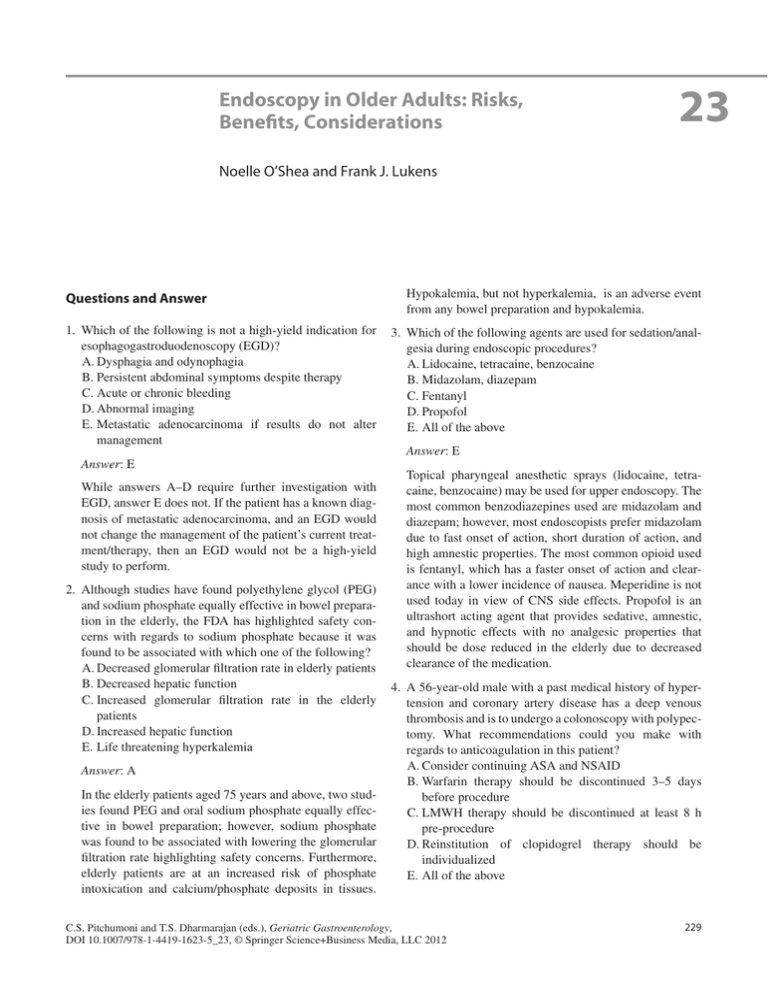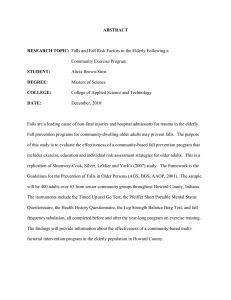23 Endoscopy in Older Adults: Risks, Benefits, Considerations
advertisement

Endoscopy in Older Adults: Risks, Benefits, Considerations 23 Noelle O’Shea and Frank J. Lukens Questions and Answer 1. Which of the following is not a high-yield indication for esophagogastroduodenoscopy (EGD)? A.Dysphagia and odynophagia B.Persistent abdominal symptoms despite therapy C.Acute or chronic bleeding D.Abnormal imaging E.Metastatic adenocarcinoma if results do not alter management Answer: E While answers A–D require further investigation with EGD, answer E does not. If the patient has a known diagnosis of metastatic adenocarcinoma, and an EGD would not change the management of the patient’s current treatment/therapy, then an EGD would not be a high-yield study to perform. 2. Although studies have found polyethylene glycol (PEG) and sodium phosphate equally effective in bowel preparation in the elderly, the FDA has highlighted safety concerns with regards to sodium phosphate because it was found to be associated with which one of the following? A.Decreased glomerular filtration rate in elderly patients B.Decreased hepatic function C.Increased glomerular filtration rate in the elderly patients D.Increased hepatic function E.Life threatening hyperkalemia Answer: A In the elderly patients aged 75 years and above, two studies found PEG and oral sodium phosphate equally effective in bowel preparation; however, sodium phosphate was found to be associated with lowering the glomerular filtration rate highlighting safety concerns. Furthermore, elderly patients are at an increased risk of phosphate intoxication and calcium/phosphate deposits in tissues. Hypokalemia, but not hyperkalemia, is an adverse event from any bowel preparation and hypokalemia. 3. Which of the following agents are used for sedation/analgesia during endoscopic procedures? A.Lidocaine, tetracaine, benzocaine B.Midazolam, diazepam C.Fentanyl D.Propofol E.All of the above Answer: E Topical pharyngeal anesthetic sprays (lidocaine, tetracaine, benzocaine) may be used for upper endoscopy. The most common benzodiazepines used are midazolam and diazepam; however, most endoscopists prefer midazolam due to fast onset of action, short duration of action, and high amnestic properties. The most common opioid used is ­fentanyl, which has a faster onset of action and clearance with a lower incidence of nausea. Meperidine is not used today in view of CNS side effects. Propofol is an ultrashort acting agent that provides sedative, amnestic, and hypnotic effects with no analgesic properties that should be dose reduced in the elderly due to decreased clearance of the medication. 4. A 56-year-old male with a past medical history of hypertension and coronary artery disease has a deep venous thrombosis and is to undergo a colonoscopy with polypectomy. What recommendations could you make with regards to anticoagulation in this patient? A.Consider continuing ASA and NSAID B.Warfarin therapy should be discontinued 3–5 days before procedure C.LMWH therapy should be discontinued at least 8 h pre-procedure D.Reinstitution of clopidogrel therapy should be individualized E.All of the above C.S. Pitchumoni and T.S. Dharmarajan (eds.), Geriatric Gastroenterology, DOI 10.1007/978-1-4419-1623-5_23, © Springer Science+Business Media, LLC 2012 229 230 Answer: E Anticoagulation recommendations in this case are based upon a high bleeding risk (colonoscopy with polypectomy) and a low thromboembolic risk (deep venous thrombosis). There is no need to discontinue aspirin or N. O’Shea and F.J. Lukens NSAIDs for routine colonoscopy and polypectomy; warfarin may be discontinued 3–5 days prior to the procedure, and LMWH at least 8 h prior to the procedure; individualize the reinstitution of clopidogrel therapy.





